Welcome to my personal website. I am a historian, author and translator living in Brussels.
My publications are mainly cultural historical explorations of religion in nineteenth- and twentieth-century Europe, specifically of the role of Catholic clergy and religious in Ireland and the Netherlands. I am an associate editor of DHGE - Louvain Dictionary of Church History and a research associate at the Faculty of Theology and Religious Studies at KU Leuven, where I am working with Stephan van Erp on a biography of the Dominican theologian Edward Schillebeeckx (1914-2009).
As a translator and editor I have had the opportunity to acquire experience in many fields, but my specialism is translating Dutch academic texts into English and editing English texts written by non-native speakers. Have a look at the Translation page for more information and contact me through the Contact page for a quote.
My publications are mainly cultural historical explorations of religion in nineteenth- and twentieth-century Europe, specifically of the role of Catholic clergy and religious in Ireland and the Netherlands. I am an associate editor of DHGE - Louvain Dictionary of Church History and a research associate at the Faculty of Theology and Religious Studies at KU Leuven, where I am working with Stephan van Erp on a biography of the Dominican theologian Edward Schillebeeckx (1914-2009).
As a translator and editor I have had the opportunity to acquire experience in many fields, but my specialism is translating Dutch academic texts into English and editing English texts written by non-native speakers. Have a look at the Translation page for more information and contact me through the Contact page for a quote.
Recent publications
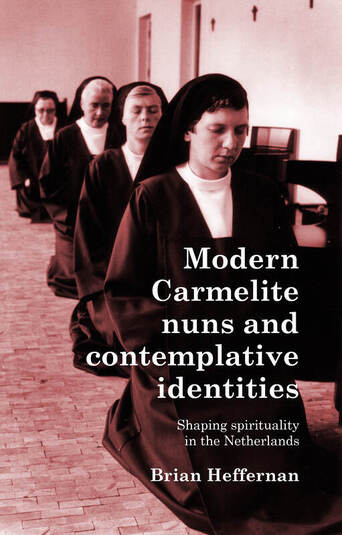
Brian Heffernan, Modern Carmelite Nuns and Contemplative Identities. Shaping Spirituality in the Netherlands (Manchester University Press, 2024)
As the Netherlands became a modern country in the nineteenth and twentieth centuries, Catholic religious life flourished, including its most radical manifestation: the contemplative life of cloistered nuns. This book examines the hidden spiritual life of the most numerous among them, the Discalced Carmelites, from their arrival in the country in 1872 up to the recent past. It draws on a range of sources, from convent archives to oral history, to analyse the evolving discourses these nuns adopted to articulate their identity as a female spiritual elite in a male-dominated church and society. Asceticism, vicarious suffering, mysticism and Therese of Lisieux’s little way were major themes whose appeal proved persistent. From the 1950s and 1960s onwards, the challenge of renewal and the turn to self prompted them to devise new narratives revolving around contemplative prayer, as they sought to adapt to a culture that accentuates ‘authentic’ experience and self-expression. Modern Carmelite Nuns and Contemplative Identities includes gendered role definitions, the distribution of power and the problem of memory in its contextualised exploration of how these women shaped their relationship with God and their role in the modern Western world.
(Abridged, adapted English translation of Radicaal kloosterleven [2021]).
As the Netherlands became a modern country in the nineteenth and twentieth centuries, Catholic religious life flourished, including its most radical manifestation: the contemplative life of cloistered nuns. This book examines the hidden spiritual life of the most numerous among them, the Discalced Carmelites, from their arrival in the country in 1872 up to the recent past. It draws on a range of sources, from convent archives to oral history, to analyse the evolving discourses these nuns adopted to articulate their identity as a female spiritual elite in a male-dominated church and society. Asceticism, vicarious suffering, mysticism and Therese of Lisieux’s little way were major themes whose appeal proved persistent. From the 1950s and 1960s onwards, the challenge of renewal and the turn to self prompted them to devise new narratives revolving around contemplative prayer, as they sought to adapt to a culture that accentuates ‘authentic’ experience and self-expression. Modern Carmelite Nuns and Contemplative Identities includes gendered role definitions, the distribution of power and the problem of memory in its contextualised exploration of how these women shaped their relationship with God and their role in the modern Western world.
(Abridged, adapted English translation of Radicaal kloosterleven [2021]).
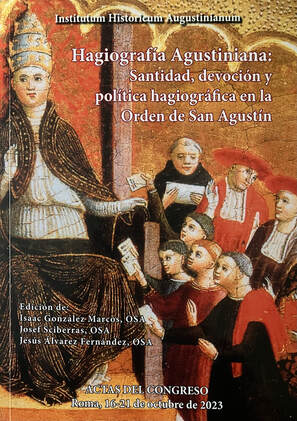
Brian Heffernan, 'Devotional Life in a Dutch Augustinian Parish Church: St Augustine's, Utrecht, 1840-2015', in: Isaac González Marcos, Josef Sciberras and Jesús Álvarez (eds.), Hagiografía Agustiniana: Santidad, devoción y política hagiográfica en la Orden de San Agustín (Rome: Institutum Historicum Augustinianum, 2023) pp. 407-421.
This chapter looks at Augustinian devotional life through the prism of a Dutch parish church, St. Augustine's on Oudegracht in Utrecht. Built in 1839-1840, it served and continues to serve as one of the principal Catholic church in Utrecht, the Netherlands' fourth-largest city. The last Augustinian parish priest departed in 2008. In the intervening 169 years, the building was a canvas to which its Augustinian ministers and their parishioners applied their ever-evolving spiritual and devotional life through statues, paintings and furnishings, and it served also as a stage upon which masses, benedictions, confessions and other performative forms of spirituality took place. This chapter uses existing literature and archival material to sketch, in broad outlines, what the history of devotional life in St. Augustine's says about Augustinian hagiography, Augustinian saints and Augustinian spirituality in the Netherlnads in the nineteenth to the twenty-first centuries.
This chapter looks at Augustinian devotional life through the prism of a Dutch parish church, St. Augustine's on Oudegracht in Utrecht. Built in 1839-1840, it served and continues to serve as one of the principal Catholic church in Utrecht, the Netherlands' fourth-largest city. The last Augustinian parish priest departed in 2008. In the intervening 169 years, the building was a canvas to which its Augustinian ministers and their parishioners applied their ever-evolving spiritual and devotional life through statues, paintings and furnishings, and it served also as a stage upon which masses, benedictions, confessions and other performative forms of spirituality took place. This chapter uses existing literature and archival material to sketch, in broad outlines, what the history of devotional life in St. Augustine's says about Augustinian hagiography, Augustinian saints and Augustinian spirituality in the Netherlnads in the nineteenth to the twenty-first centuries.
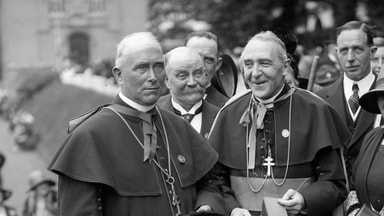
Brian Heffernan, 'The Catholic Church and the Irish Civil War', RTÉ History, 18 August 2022
While the Catholic Church beecame one of the most important pro-Treaty organisations in the country, some individual clerics offered support to the anti-Treaty side during the Civil War, as Brian Heffernan explains.
While the Catholic Church beecame one of the most important pro-Treaty organisations in the country, some individual clerics offered support to the anti-Treaty side during the Civil War, as Brian Heffernan explains.
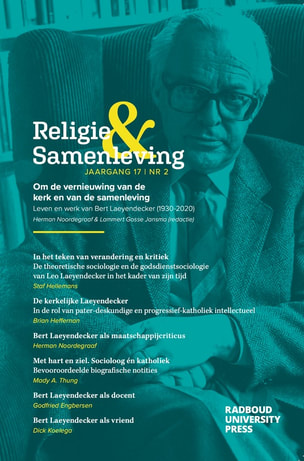
Brian Heffernan, 'De kerkelijke Laeyendecker. In de rol van pater-deskundige en progressief-katholiek intellectueel', Religie en Samenleving, 17/2 (2022) pp. 95-115.
Leo Laeyendecker was not just a renowned sociologist, he was also a prominent voice in late-twentieth-century Dutch Catholicism, first as an Augustinian priest and then as a progressive public intellectual. This article offers a biographical sketch of the Catholic Laeyendecker, and focuses specifically on his performance of the roles of priest-scientist and Catholic public intellectual. He became a sociologist at the behest of his superiors, who hoped he would be able to assist church leadership with scientifically sound policy advice. But once he had completed his training, his objective as a priest-scientist was to use sociological analyses to convince his fellow friars and Catholics that the realities of modernity militated for church renewal. As a public intellectual, he continued to advocate a progressive agenda in an era in which church leaders were retreating from the specific reformist stance of their predecessors. This new context prompted another change of role, from that of a voice within the wider church community to that of theorist of its progressive wing.
Leo Laeyendecker was not just a renowned sociologist, he was also a prominent voice in late-twentieth-century Dutch Catholicism, first as an Augustinian priest and then as a progressive public intellectual. This article offers a biographical sketch of the Catholic Laeyendecker, and focuses specifically on his performance of the roles of priest-scientist and Catholic public intellectual. He became a sociologist at the behest of his superiors, who hoped he would be able to assist church leadership with scientifically sound policy advice. But once he had completed his training, his objective as a priest-scientist was to use sociological analyses to convince his fellow friars and Catholics that the realities of modernity militated for church renewal. As a public intellectual, he continued to advocate a progressive agenda in an era in which church leaders were retreating from the specific reformist stance of their predecessors. This new context prompted another change of role, from that of a voice within the wider church community to that of theorist of its progressive wing.
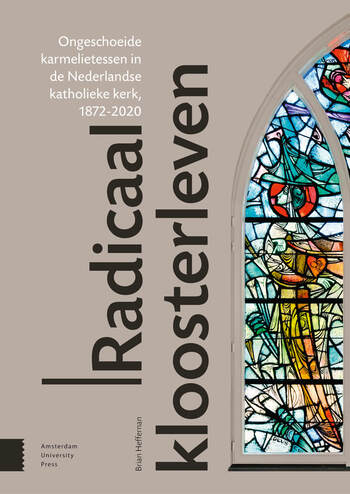
Brian Heffernan, Radicaal kloosterleven. Ongeschoeide karmelietessen in de Nederlandse katholieke kerk, 1872-2020 (Amsterdam: Amsterdam University Press, 2021). (Radical Religious life: Discalced Carmelite Nuns in the Dutch Catholic Church, 1872-2020)
This book recounts the history of the Discalced Carmelite nuns in the Netherlands since the nineteenth century: Catholic sisters who lived in the cloister, following the example of Teresa of Avila (1515-1582). The contemplative life flourished at the very time that the Netherlands became a modern country. Women and men sought the isolation of the cloistered life in their monasteries to focus on prayer and the practice of asceticism. Their life appealed to the imagination, and in many respects it became emblematic for Catholicism in general.
This cultural historical study focuses on the largest group of contemplative sisters in the Netherlands. Heffernan describes who the Discalced Carmelite nuns were, why they chose this form of life, how power was distributed in their convents, what concepts they formed about their life, when and why these changed, and the images the outside world had of them. It is a fascinating history of one of the most radical forms of female religious life that the Netherlands has known.
'... grondig onderzoek ... standaardwerk' - Willem Bouwman, Nederlands Dagblad (14 January 2022)
'duidelijke onderverdeling ... van een imponerende omvang maar ik heb het van begin tot eind met veel plezier en interesse gelezen ... intrigerend inkijkje' - Tanja van Leeuwen, ZijSpiegel (May 2022) 12
'Heffernan wil laten zien dat hun leefwijze in de loop van hun geschiedenis voor henzelf, families, kerkleden en de samenleving niet steeds hetzelfde betekende ... verhelderend, al is het boek door de opdeling in thematische hoofdstukken niet makkelijk te lezen' - Peter van Dam, Geschiedenis Magazine, 4 (June 2022) 52
'Heffernan ... beschrijft het verborgen leven van de zusters in een omvangrijk boek ... dat nergens verveelt. ... "Radicaal kloosterleven" heet het ... Het ... maakt duidelijk dat die radicaliteit de nodige problemen met zich mee kon brengen. ... Lees en huiver' - Peter Nissen, 'Van de schoonheid en de troost' 779, Facebook, 6 June 2022
'een totaalportret ... Daarbij focust hij op de vraag welke betekenis het door hem zelf als "radicaal" getypeerde kloosterleven van deze slotzusters had ... Doorheen zijn boeiende verhaal laat hij zien dat het, synchroon zowel als diachroon, om een diversiteit van betekenissen is gegaan. De opzet van het boek is helder en consistent. ... Het merendeel van de hoofdstukken wordt afgesloten met een beknopte, maar zorgvuldig gecomponeerde conclusie. ... hij [heeft] er ... voor gezorgd dat als erfgoed voorgoed behouden blijft wat deze karmelietessen aan spirituele tradities belichaamd hebben' - Jan Jacobs, Tijdschrift voor Nederlandse Kerkgeschiedenis, 25/3 (2022) 128-129
'Typerend voor de werkwijze van Hefferman [sic] is dat hij zichzelf positioneert als een van buitenaf waarnemende en analyserende academicus ... [hij] is zich bewust van zijn eigen vooronderstellingen en legt die zorgvuldig uit. ... Verschil in taal tussen de auteur en degenen die hij beschrijft werkt in de praktijk echter nauwelijks storend. ... [het] is ... de bedoeling om het zelfbeeld van de betrokkenen te reconstrueren, in hun eigen termen, niet om te oordelen aan de hand van een externe maatstaf' - Gert van Klinken, Documentatieblad voor de Nederlandse Kerkgeschiedenis na 1800, XLV/97 (2022) 243-245
'... goed in geslaagd om een beeld op te roepen van de religieuze gedrevenheid van de zusters en de soms wel bizarre gebruiken in de vooroorlogse jaren. Het is de auteur gelukt om steeds afstand te bewaren ... een sobere maar prettig leesbare stijl' - Frans Savelkouls, Kerk-Krant. Geloofsgemeenschap Augustinus Eindhoven, 11/2 (2023) 9
'... indrukwekkend ... geenszins een traditioneel jubileumboek. In een corpus van nagenoeg zevenhonderd pagina's brengt de auteur het gedetailleerde, maar tegelijkertijd breed gecontextualiseerde en kritisch geanalyseerde verhaal van de Nederlandse karmelietessen. ... een interessante aanvulling en verdieping van het onderzoek naar de interactie tussen vrouwen, kerk en religie. ... het is de kracht van deze publicatie dat Heffernan zowel het institutionele als persoonlijke, emotionele aspect van dit proces [van sluiting van kloosters] weet te belichten. De sterke interactie tussen deze beide perspectieven is de belangrijkste troef van Radicaal kloosterleven en wordt nog versterkt door de brede inbedding in internationale literatuur. ... soms een ietwat repetitief karakter ... Dit doet geen afbreuk aan het feit dat deze publicatie voor het contemplatieve leven in Nederland een nieuwe standaard zet' - Kristien Suenens, BMGN - Low Countries Historical Review, 138 (2023)
This book recounts the history of the Discalced Carmelite nuns in the Netherlands since the nineteenth century: Catholic sisters who lived in the cloister, following the example of Teresa of Avila (1515-1582). The contemplative life flourished at the very time that the Netherlands became a modern country. Women and men sought the isolation of the cloistered life in their monasteries to focus on prayer and the practice of asceticism. Their life appealed to the imagination, and in many respects it became emblematic for Catholicism in general.
This cultural historical study focuses on the largest group of contemplative sisters in the Netherlands. Heffernan describes who the Discalced Carmelite nuns were, why they chose this form of life, how power was distributed in their convents, what concepts they formed about their life, when and why these changed, and the images the outside world had of them. It is a fascinating history of one of the most radical forms of female religious life that the Netherlands has known.
'... grondig onderzoek ... standaardwerk' - Willem Bouwman, Nederlands Dagblad (14 January 2022)
'duidelijke onderverdeling ... van een imponerende omvang maar ik heb het van begin tot eind met veel plezier en interesse gelezen ... intrigerend inkijkje' - Tanja van Leeuwen, ZijSpiegel (May 2022) 12
'Heffernan wil laten zien dat hun leefwijze in de loop van hun geschiedenis voor henzelf, families, kerkleden en de samenleving niet steeds hetzelfde betekende ... verhelderend, al is het boek door de opdeling in thematische hoofdstukken niet makkelijk te lezen' - Peter van Dam, Geschiedenis Magazine, 4 (June 2022) 52
'Heffernan ... beschrijft het verborgen leven van de zusters in een omvangrijk boek ... dat nergens verveelt. ... "Radicaal kloosterleven" heet het ... Het ... maakt duidelijk dat die radicaliteit de nodige problemen met zich mee kon brengen. ... Lees en huiver' - Peter Nissen, 'Van de schoonheid en de troost' 779, Facebook, 6 June 2022
'een totaalportret ... Daarbij focust hij op de vraag welke betekenis het door hem zelf als "radicaal" getypeerde kloosterleven van deze slotzusters had ... Doorheen zijn boeiende verhaal laat hij zien dat het, synchroon zowel als diachroon, om een diversiteit van betekenissen is gegaan. De opzet van het boek is helder en consistent. ... Het merendeel van de hoofdstukken wordt afgesloten met een beknopte, maar zorgvuldig gecomponeerde conclusie. ... hij [heeft] er ... voor gezorgd dat als erfgoed voorgoed behouden blijft wat deze karmelietessen aan spirituele tradities belichaamd hebben' - Jan Jacobs, Tijdschrift voor Nederlandse Kerkgeschiedenis, 25/3 (2022) 128-129
'Typerend voor de werkwijze van Hefferman [sic] is dat hij zichzelf positioneert als een van buitenaf waarnemende en analyserende academicus ... [hij] is zich bewust van zijn eigen vooronderstellingen en legt die zorgvuldig uit. ... Verschil in taal tussen de auteur en degenen die hij beschrijft werkt in de praktijk echter nauwelijks storend. ... [het] is ... de bedoeling om het zelfbeeld van de betrokkenen te reconstrueren, in hun eigen termen, niet om te oordelen aan de hand van een externe maatstaf' - Gert van Klinken, Documentatieblad voor de Nederlandse Kerkgeschiedenis na 1800, XLV/97 (2022) 243-245
'... goed in geslaagd om een beeld op te roepen van de religieuze gedrevenheid van de zusters en de soms wel bizarre gebruiken in de vooroorlogse jaren. Het is de auteur gelukt om steeds afstand te bewaren ... een sobere maar prettig leesbare stijl' - Frans Savelkouls, Kerk-Krant. Geloofsgemeenschap Augustinus Eindhoven, 11/2 (2023) 9
'... indrukwekkend ... geenszins een traditioneel jubileumboek. In een corpus van nagenoeg zevenhonderd pagina's brengt de auteur het gedetailleerde, maar tegelijkertijd breed gecontextualiseerde en kritisch geanalyseerde verhaal van de Nederlandse karmelietessen. ... een interessante aanvulling en verdieping van het onderzoek naar de interactie tussen vrouwen, kerk en religie. ... het is de kracht van deze publicatie dat Heffernan zowel het institutionele als persoonlijke, emotionele aspect van dit proces [van sluiting van kloosters] weet te belichten. De sterke interactie tussen deze beide perspectieven is de belangrijkste troef van Radicaal kloosterleven en wordt nog versterkt door de brede inbedding in internationale literatuur. ... soms een ietwat repetitief karakter ... Dit doet geen afbreuk aan het feit dat deze publicatie voor het contemplatieve leven in Nederland een nieuwe standaard zet' - Kristien Suenens, BMGN - Low Countries Historical Review, 138 (2023)
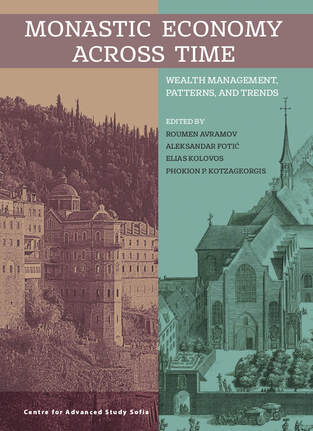
Brian Heffernan, 'Nuns' Funds. The 1874 and 1925 Accounts of the Carmel of 's-Hertogenbosch, the Netherlands', in: Roumen Avramov et al. (eds.), Monastic Economy Across Time. Wealth Management, Patterns, and Trends (Sofia: Centre for Advanced Study, 2021), pp. 197-217.
The flourishing of Roman Catholic religious life in the Netherlands in the nineteenth and twentieth century was the result of many factors. Finances were an important aspect: the rise of religious institutes cost money, and religious devised various ways of generating revenue. Historians have studied the business model of active congregations, but have given much less attention to that of contemplative religious. These nonetheless also experienced both numerical and financial growth during this period.
This paper will inquire into the costs and revenues of the contemplative life by looking at two snapshots from the financial history of the Carmel of ’s-Hertogenbosch. This convent (1872-1971) was the first of the Order of Discalced Carmelite Nuns to be founded in the Netherlands after the French Revolution, and it was long the country’s most prominent Carmel. Close inspection of its annual accounts for the years 1874 and 1925 can reveal much about how the contemplative life was financed at a time of new beginnings and of expansion.
The paper will be based on the convent’s archives and diocesan archives, and on additional material relating to other Carmels in the Netherlands. It will examine the case of this Carmel using the framework of the ‘Economics of Providence’ that Maarten Van Dijck and Jan De Maeyer outlined in their eponymous 2012 volume. An extended, Dutch-language version of this paper is due to be published in a collection of essays in the Netherlands in 2019; the current contribution seeks to make the results available to an international audience.
Translated and abridged version of my chapter in Marie-Antoinette Willemsen (ed.), Werven en derven. De financiële grondslag van kloostergemeenschappen in de Lage Landen (Hilversum: Verloren, 2019).
The flourishing of Roman Catholic religious life in the Netherlands in the nineteenth and twentieth century was the result of many factors. Finances were an important aspect: the rise of religious institutes cost money, and religious devised various ways of generating revenue. Historians have studied the business model of active congregations, but have given much less attention to that of contemplative religious. These nonetheless also experienced both numerical and financial growth during this period.
This paper will inquire into the costs and revenues of the contemplative life by looking at two snapshots from the financial history of the Carmel of ’s-Hertogenbosch. This convent (1872-1971) was the first of the Order of Discalced Carmelite Nuns to be founded in the Netherlands after the French Revolution, and it was long the country’s most prominent Carmel. Close inspection of its annual accounts for the years 1874 and 1925 can reveal much about how the contemplative life was financed at a time of new beginnings and of expansion.
The paper will be based on the convent’s archives and diocesan archives, and on additional material relating to other Carmels in the Netherlands. It will examine the case of this Carmel using the framework of the ‘Economics of Providence’ that Maarten Van Dijck and Jan De Maeyer outlined in their eponymous 2012 volume. An extended, Dutch-language version of this paper is due to be published in a collection of essays in the Netherlands in 2019; the current contribution seeks to make the results available to an international audience.
Translated and abridged version of my chapter in Marie-Antoinette Willemsen (ed.), Werven en derven. De financiële grondslag van kloostergemeenschappen in de Lage Landen (Hilversum: Verloren, 2019).
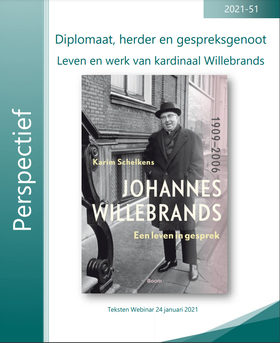
Brian Heffernan, 'Willebrands de zielzorger - van kapelaan tot eminentie', Perspectief, 51 (2021), pp. 8-14.
Speech at a webinar held on 24 January 2021 to mark the publication of Karim Schelkens' biography of Johannes Cardinal Willebrands, specifically on Willebrands the priest and on his term as Archbishop of Utrecht (1975-1983).
Speech at a webinar held on 24 January 2021 to mark the publication of Karim Schelkens' biography of Johannes Cardinal Willebrands, specifically on Willebrands the priest and on his term as Archbishop of Utrecht (1975-1983).
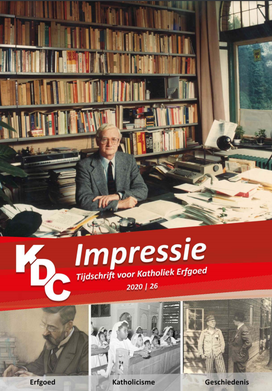
Brian Heffernan, '"Geen heil buiten de wereld om". Het archief van Edward Schillebeeckx ontsloten', KDC Impressie, 26 (2020), pp. 4-7.
The cataloguing of the papers of Professor Edward Schillebeeckx O.P. was completed in early 2020. Schillebeeckx (Antwerp 1914 - Nijmegen 2009) was one of the most influential theologians of the last century and is the subject of many publications. Historian Brian Heffernan, specialised in the modern history of Catholicism and Catholic theology, is the first researcher to have looked extensively at his papers. The editors of KDC Impressie asked him for his first impressions.
The cataloguing of the papers of Professor Edward Schillebeeckx O.P. was completed in early 2020. Schillebeeckx (Antwerp 1914 - Nijmegen 2009) was one of the most influential theologians of the last century and is the subject of many publications. Historian Brian Heffernan, specialised in the modern history of Catholicism and Catholic theology, is the first researcher to have looked extensively at his papers. The editors of KDC Impressie asked him for his first impressions.
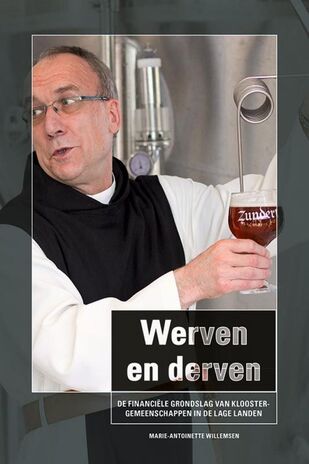
Brian Heffernan, 'De prijs van gebed. Twee momentopnamen uit de financiële geschiedenis van de karmel van 's-Hertogenbosch (1874 en 1925)', in Marie-Antoinette Willemsen (ed.), Werven en derven. De financiële grondslag van kloostergemeenschappen in de Lage Landen (Hilversum: Verloren, 2019), pp. 15-33.
The growth of the religious life in the Netherlands during the nineteenth and twentieth centuries was the result of many factors: religious, political and social. One important precondition that has had little attention from historians is that of finances. There was a price to pay for the growth of religious orders and congregations. This article looks at the 'price of prayer': the costs and revenues of the contemplative life in its modern period of flourishing. It does this on the basis of two micro studies of the accounts of one specific enclosed convent for two sample years: Saint Anne's convent of the Discalced Carmelite sisters on Clarastraat in 's-Hertogenbosch for the years 1874 and 1925.
The growth of the religious life in the Netherlands during the nineteenth and twentieth centuries was the result of many factors: religious, political and social. One important precondition that has had little attention from historians is that of finances. There was a price to pay for the growth of religious orders and congregations. This article looks at the 'price of prayer': the costs and revenues of the contemplative life in its modern period of flourishing. It does this on the basis of two micro studies of the accounts of one specific enclosed convent for two sample years: Saint Anne's convent of the Discalced Carmelite sisters on Clarastraat in 's-Hertogenbosch for the years 1874 and 1925.
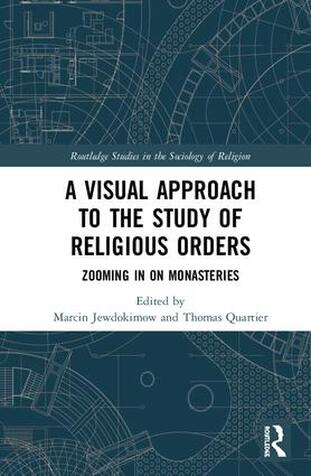
Brian Heffernan, 'Photographing Friars: Visualising the History of Changing Dutch Augustinian Identities', in Marcin Jewdokimow and Thomas Quartier (eds.), A Visual Approach to the Study of Religious Orders. Zooming in on Monasteries (London and New York:
Routledge, 2019), pp. 18-32.
Historians have for some time now been alert to the fact that visual material is as suitable a source for the practice of history as are written texts. This is also true of historians of religion, and it has led in the Netherlands to many initiatives to collect, preserve and inventory visual material. The current volume goes beyond this endeavour by applying visual methods to the exploration of various facets of religious life in the form of 'visual essays'. The book treats these not as simple illustrations but as an autonomous form of expression, capable of unveiling vital and developmental layers of experience, while inviting readers to examine and interpret the data themselves.. This chapter uses this genre of the visual essay to practice cultural history. It takes the Dutch province of the Order of Saint Augustine as its subject, and uses a series of 16 photographs, mainly sourced from the archives of the province, to tell the story of changing identities of Dutch Augustinians.
Routledge, 2019), pp. 18-32.
Historians have for some time now been alert to the fact that visual material is as suitable a source for the practice of history as are written texts. This is also true of historians of religion, and it has led in the Netherlands to many initiatives to collect, preserve and inventory visual material. The current volume goes beyond this endeavour by applying visual methods to the exploration of various facets of religious life in the form of 'visual essays'. The book treats these not as simple illustrations but as an autonomous form of expression, capable of unveiling vital and developmental layers of experience, while inviting readers to examine and interpret the data themselves.. This chapter uses this genre of the visual essay to practice cultural history. It takes the Dutch province of the Order of Saint Augustine as its subject, and uses a series of 16 photographs, mainly sourced from the archives of the province, to tell the story of changing identities of Dutch Augustinians.
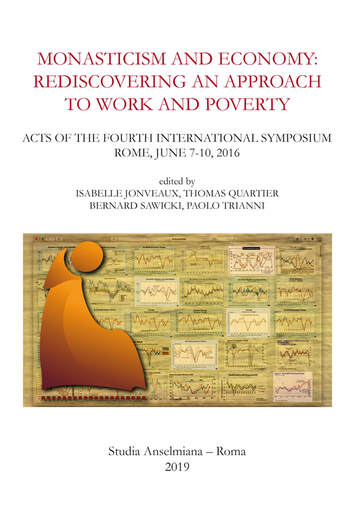
Brian Heffernan, 'Sint vobis omnia communia. Conceptions of Religious Poverty among the Dutch Augustinian Friars, 1886-2006', in Isabelle Jonveaux, Thomas Quartier, Bernard Sawicki, and Paolo Trianni (eds.), Monasticism and Economy: Rediscovering an Approach to Work and Poverty (Rome: Pontificio Ateneo S. Anselmo and Editions Sankt-Ottilien, 2019), pp. 223-34.
As do other monastic rules, the Rule of Saint Augustine stipulates that those who live in community must not call anything their own, but should possess everything in common. The practical application of this precept is an important touchstone of the radicalism of the religious life, and gauging conceptions of religious poverty is therefore a significant heuristic device for the historian of religious institutes. As Dutch Catholicism experienced a revival in the nineteenth century, it discovered the mobilising force of those aspects of Catholic tradition that were least acceptable to non-Catholic society, one of them being a more radical ideal of the religious life. For the ‘old orders’ of mendicant friars, many of whom had been exclusively involved in parish ministry for centuries, revival came in the form of a campaign of ‘monasticisation’. The introduction of the vita communis perfecta was an important aspect of this campaign.
This historical paper examines this process by taking the Dutch Augustinian Friars as a case. It starts with their founding of a first post-Reformation Augustinian priory in the Netherlands in 1886, and analyses their changing perceptions of religious poverty in the 120 years that followed. ‘Monasticisation’ gave way in the interwar years to the search for a sophisticated spirituality in which the concepts of community and communal property played an important role. After the Second World War, and particularly in the 1960s, Dutch Augustinians looked critically at all aspects of their religious heritage. Many discarded traditional interpretations of the precept of religious poverty as being restrictive of free individual commitment and personal fulfilment. This changed again as interest in the spirituality of Augustine experienced a revival in the province from the 1980s onwards. In describing conceptions of religious poverty among the Dutch Augustinians, this paper shows how changing interpretations of this particular evangelical counsel can point to underlying shifts in the place of religion in modern Western society.
As do other monastic rules, the Rule of Saint Augustine stipulates that those who live in community must not call anything their own, but should possess everything in common. The practical application of this precept is an important touchstone of the radicalism of the religious life, and gauging conceptions of religious poverty is therefore a significant heuristic device for the historian of religious institutes. As Dutch Catholicism experienced a revival in the nineteenth century, it discovered the mobilising force of those aspects of Catholic tradition that were least acceptable to non-Catholic society, one of them being a more radical ideal of the religious life. For the ‘old orders’ of mendicant friars, many of whom had been exclusively involved in parish ministry for centuries, revival came in the form of a campaign of ‘monasticisation’. The introduction of the vita communis perfecta was an important aspect of this campaign.
This historical paper examines this process by taking the Dutch Augustinian Friars as a case. It starts with their founding of a first post-Reformation Augustinian priory in the Netherlands in 1886, and analyses their changing perceptions of religious poverty in the 120 years that followed. ‘Monasticisation’ gave way in the interwar years to the search for a sophisticated spirituality in which the concepts of community and communal property played an important role. After the Second World War, and particularly in the 1960s, Dutch Augustinians looked critically at all aspects of their religious heritage. Many discarded traditional interpretations of the precept of religious poverty as being restrictive of free individual commitment and personal fulfilment. This changed again as interest in the spirituality of Augustine experienced a revival in the province from the 1980s onwards. In describing conceptions of religious poverty among the Dutch Augustinians, this paper shows how changing interpretations of this particular evangelical counsel can point to underlying shifts in the place of religion in modern Western society.
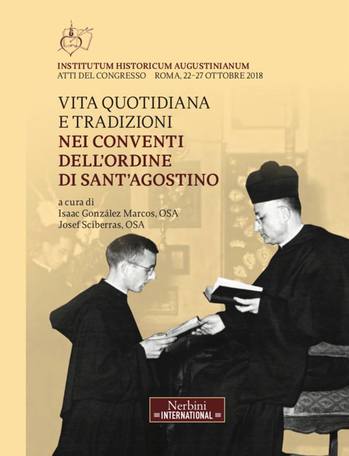
Brian Heffernan, 'Daily Life as a Forum for Religious Reform in Dutch Augustinian Friaries, 1960-1980', in Isaac González Marcos and Josef Sciberras (eds.), Vita quotidiana e tradizioni nei conventi dell'Ordine di Sant'Agostino (Rome: Institutum Historicum Augustinianum, 2018), pp. 163-174.
Descriptions of how the Second Vatican Council changed religious life can and should concentrate on its call to return to the charism of the founder. Focusing on spiritual developments alone, however, risks losing sight of the fact that another important transformation was underway, one which occupied the minds of reformers just as much as theology or spirituality: practices of daily life in the friary - or the monastery, or the convent, or the religious house in general - were being contested, defended, and changed. This article describes the changes that the Dutch province of the Order of Saint Augustine underwent from 1960 to 1980 from the perspective of daily life as a forum for religious reform.
Descriptions of how the Second Vatican Council changed religious life can and should concentrate on its call to return to the charism of the founder. Focusing on spiritual developments alone, however, risks losing sight of the fact that another important transformation was underway, one which occupied the minds of reformers just as much as theology or spirituality: practices of daily life in the friary - or the monastery, or the convent, or the religious house in general - were being contested, defended, and changed. This article describes the changes that the Dutch province of the Order of Saint Augustine underwent from 1960 to 1980 from the perspective of daily life as a forum for religious reform.
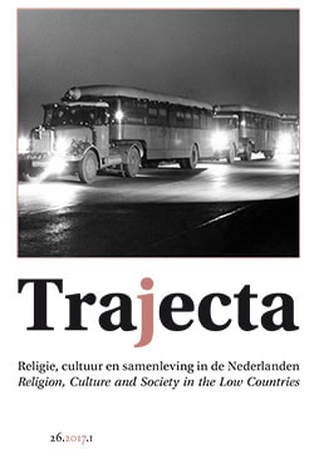
Brian Heffernan, 'Dutch Augustinians, appropriations of Augustine, and ressourcement in the nineteenth and twentieth Centuries', Trajecta. Religion, Culture and Society in the Low Countries, 26:1 (2017), pp. 45-65.
Together with such concepts as aggiornamento, ‘reading the signs of the times’, and the ‘universal call to holiness’, ressourcement was one of the cornerstones of the Second Vatican Council’s (1962-1965) reform project. For religious institutes in particular, it became a leading principle in their postconciliar attempts to return to the ‘charism of their founder’. Reform-minded intellectuals proposed ressourcement as a way of remedying the problems that they believed beset the religious life of their time, by making a clean break with rigid and formalistic accretions accumulated over the centuries in order to return to the institutes’ authentic, original inspiration. Ressourcement was thus conceived as a way of making new beginnings by effecting a rupture with the recent past.
This article takes the Dutch Augustinians as a case study and looks specifically at their various appropriations of the order’s primary founder figure, Augustine of Hippo. The example of the Dutch Augustinians illustrates the fact that the call for ressourcement, so far from being a conciliar invention, was in fact the product of the preconciliar Catholicism that reformers were so keen to repudiate. In the 1930s, it had inspired Dutch Augustinian endeavours to create a militant, virile ethos. For the generation of friars who came of age during the council, ressourcement was associated with reactionary efforts to stifle ‘real’, radical reform, and little attention was paid to it in the Dutch province during the 1960s and 1970s. It was not until the 1980s that a new interest in Augustine as the author of a particular school of spirituality emerged and managed to gain support from both the province’s progressive and its traditionalist wings.
This article thus charts the history of Dutch Augustinian appropriations of Augustine. In doing so it contends that students of ressourcement as a driver of change in the history of religious institutes should divest themselves of the paradigm of ‘good’ rupture and ‘bad’ continuity. This paradigm, produced and promoted by the reformists of the conciliar era, has also found its way into much subsequent historical analysis. In fact, however, it obscures the complexities of the actual uses of ressourcement by various historical agents. Attempts to make historical sense of the conciliar reforms should instead pay close attention to the specific meaning that specific groups assigned to them at any given time.
Together with such concepts as aggiornamento, ‘reading the signs of the times’, and the ‘universal call to holiness’, ressourcement was one of the cornerstones of the Second Vatican Council’s (1962-1965) reform project. For religious institutes in particular, it became a leading principle in their postconciliar attempts to return to the ‘charism of their founder’. Reform-minded intellectuals proposed ressourcement as a way of remedying the problems that they believed beset the religious life of their time, by making a clean break with rigid and formalistic accretions accumulated over the centuries in order to return to the institutes’ authentic, original inspiration. Ressourcement was thus conceived as a way of making new beginnings by effecting a rupture with the recent past.
This article takes the Dutch Augustinians as a case study and looks specifically at their various appropriations of the order’s primary founder figure, Augustine of Hippo. The example of the Dutch Augustinians illustrates the fact that the call for ressourcement, so far from being a conciliar invention, was in fact the product of the preconciliar Catholicism that reformers were so keen to repudiate. In the 1930s, it had inspired Dutch Augustinian endeavours to create a militant, virile ethos. For the generation of friars who came of age during the council, ressourcement was associated with reactionary efforts to stifle ‘real’, radical reform, and little attention was paid to it in the Dutch province during the 1960s and 1970s. It was not until the 1980s that a new interest in Augustine as the author of a particular school of spirituality emerged and managed to gain support from both the province’s progressive and its traditionalist wings.
This article thus charts the history of Dutch Augustinian appropriations of Augustine. In doing so it contends that students of ressourcement as a driver of change in the history of religious institutes should divest themselves of the paradigm of ‘good’ rupture and ‘bad’ continuity. This paradigm, produced and promoted by the reformists of the conciliar era, has also found its way into much subsequent historical analysis. In fact, however, it obscures the complexities of the actual uses of ressourcement by various historical agents. Attempts to make historical sense of the conciliar reforms should instead pay close attention to the specific meaning that specific groups assigned to them at any given time.
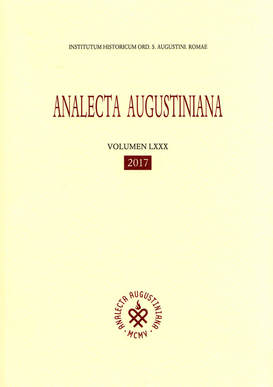
Brian Heffernan, 'Contested Augustinian revival in the Netherlands during the nineteenth century', Analecta Augustiniana, 80 (2017), pp. 185-207.
The nineteenth century saw a remarkable flourishing of the religious life in the Netherlands, as elsewhere in Western Europe. But the Dutch Augustinian Friars lagged behind their more numerous and successful Dominican and Franciscan competitors, defying attempts at revival until the 1880s. This article endeavours to explain what motivated them to resist for so long and what eventually convinced them to relinquish their opposition. It will demonstrate that their complex relationship with their Belgian confreres was key, as traditional attitudes fused with contemporary concerns about the place of Catholicism and the religious life in the Netherlands.
The nineteenth century saw a remarkable flourishing of the religious life in the Netherlands, as elsewhere in Western Europe. But the Dutch Augustinian Friars lagged behind their more numerous and successful Dominican and Franciscan competitors, defying attempts at revival until the 1880s. This article endeavours to explain what motivated them to resist for so long and what eventually convinced them to relinquish their opposition. It will demonstrate that their complex relationship with their Belgian confreres was key, as traditional attitudes fused with contemporary concerns about the place of Catholicism and the religious life in the Netherlands.
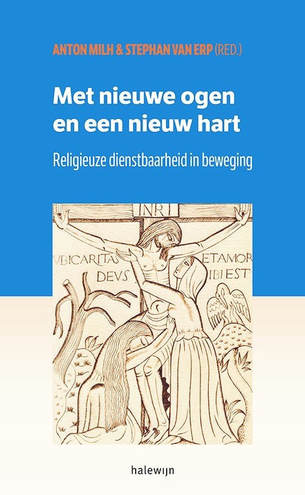
Brian Heffernan, 'Dienstbaarheid in vernieuwing. Een blik op de recente geschiedenis van Nederlandse religieuzen', in Anton Milh and Stephan van Erp (eds.), Met nieuwe ogen en een nieuw hart. Religieuze dienstbaarheid in beweging (Antwerpen: Halewijn, 2017), pp. 25-36.
Through their religious and social activities religious orders and congregations have played an important role in the construction of various societies in the nineteenth and twentieth centuries. The rise of the welfare state has often made their participation in social fields of activity obsolete, while dechristianisation has marginalised their religious activities and depleted their numbers. This decline dominates the historiography of post-war religious life in Western Europe. Inevitable as this may be, it would be a mistake to reduce the recent history of religious to a long-drawn out deathbed. Not only have some institutes managed to attract new recruits, but their decline began in their prime - precisely the last cohorts of religious were often numerous and strongly vital. Their history over the last few decades must be regarded on its own terms, and should not be written off as an epiphenomenon of extinction.
Through their religious and social activities religious orders and congregations have played an important role in the construction of various societies in the nineteenth and twentieth centuries. The rise of the welfare state has often made their participation in social fields of activity obsolete, while dechristianisation has marginalised their religious activities and depleted their numbers. This decline dominates the historiography of post-war religious life in Western Europe. Inevitable as this may be, it would be a mistake to reduce the recent history of religious to a long-drawn out deathbed. Not only have some institutes managed to attract new recruits, but their decline began in their prime - precisely the last cohorts of religious were often numerous and strongly vital. Their history over the last few decades must be regarded on its own terms, and should not be written off as an epiphenomenon of extinction.
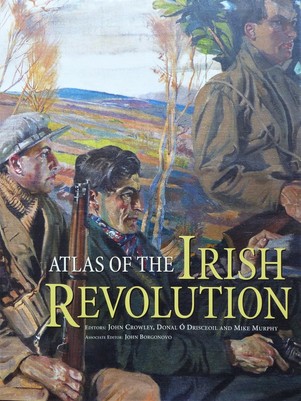
Brian Heffernan, 'The Catholic Church and the War of Independence', in John Crowley et al. (eds), Atlas of the Irish Revolution (Cork: Cork University Press, 2017), pp. 497-504.
The Atlas of the Irish Revolution draws together existing and ongoing new research into the revolutionary period in a broad ranging and inclusive manner. It includes contributions from leading scholars across a range of disciplines, incorporating the 'big issues' - such as gender, class, community, religion and ethnicity, the nature of violence, periodization and the geography of revolution - while also maintaining a close focus on events as they impacted at a local level. The analysis of conditions in the provinces, counties and parishes tells the stories of particular individuals and families caught up in the events of these years. The spatial/cartographic emphasis required the production of a range of new data that is represented locally, regionally, nationally (across the thirty-two counties) and internationally; this adds an important new dimension to our understanding of the period and to the historical geography of the revolutionary years. The Atlas also includes sections on the evolution of revolution, and on its aftermath, legacy and the collective memory and cultural representation of this fascinating, transformative period of Irish history.
My contribution discusses the attitude of Catholic priests to the guerilla struggle during the War of Independence (1919-21).
The Atlas of the Irish Revolution draws together existing and ongoing new research into the revolutionary period in a broad ranging and inclusive manner. It includes contributions from leading scholars across a range of disciplines, incorporating the 'big issues' - such as gender, class, community, religion and ethnicity, the nature of violence, periodization and the geography of revolution - while also maintaining a close focus on events as they impacted at a local level. The analysis of conditions in the provinces, counties and parishes tells the stories of particular individuals and families caught up in the events of these years. The spatial/cartographic emphasis required the production of a range of new data that is represented locally, regionally, nationally (across the thirty-two counties) and internationally; this adds an important new dimension to our understanding of the period and to the historical geography of the revolutionary years. The Atlas also includes sections on the evolution of revolution, and on its aftermath, legacy and the collective memory and cultural representation of this fascinating, transformative period of Irish history.
My contribution discusses the attitude of Catholic priests to the guerilla struggle during the War of Independence (1919-21).
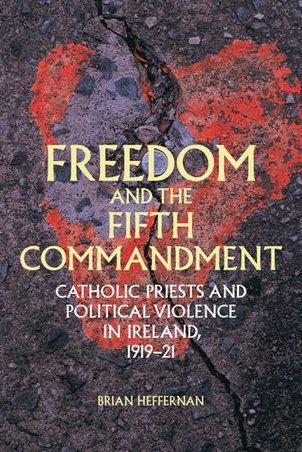
Out now: the paperback version of
Brian Heffernan, Freedom and the Fifth Commandment. Catholic priests and political violence in Ireland, 1919-21 (Manchester and New York: Manchester University Press, 2014).
The guerrilla war waged between the IRA and the crown forces between 1919 and 1921 was a pivotal episode in the modern history of Ireland. This book addresses the War of Independence from a new perspective by focusing on the attitude of a powerful social elite: the Catholic clergy. The close relationship between Irish nationalism and Catholicism was put to the test when a pugnacious new republicanism emerged after the 1916 Easter rising. When the IRA and the crown forces became involved in a guerrilla war between 1919 and 1921, priests had to define their position anew.
Using a wealth of source material, much of it newly available, this book assesses the clergy’s response to political violence. It describes how the image of shared victimhood at the hands of the British helped to contain tensions between the clergy and the republican movement, and shows how the links between Catholicism and Irish nationalism were sustained.
'A page-turner ... beautifully shaped ... [a] fine study which will be a standard work on this subject for many years to come' - J. Anthony Gaughan in The Irish Catholic (19 June 2014)
'Meticulously using both archival and newspaper sources ... [a] worthwhile study' - James Flint in The Journal of Ecclesiastical History, 66, 2 (April 2015).
'Stands out ... expertly chronicles the relationship between Catholic priests and violence in Ireland from 1919 to 1921. Heffernan has vividly filled a large gap in historical knowledge about how priests navigated exceptionally difficult circumstances and volatile times' - Diarmaid Ferriter in The Irish Times (5 December 2015).
'... hugely impressive, illuminating and excellently researched book. Drawing on diocesan archives, newspapers, witness statements and contemporary correspondence, Heffernan skilfully weaves these sources together into a judicious, well-written overview' - Diarmaid Ferriter in The Irish Times (9 January 2016).
'Using a variety of previously unexplored primary sources, Heffernan examines how Catholic clerics interacted and considered the new revolutionary movement, and how the revolutionaries and their opponents engaged with clerics. ... Roy Foster has written of a distinct "revolutionary generation" emerging in opposition to the achievements of the earlier generation ... and Heffernan shows that this extended to the Church. ... One of the many strengths of this book is that it examines how crown forces interacted with the Catholic Church .... riveting publication' - Thomas FitzGerald in Dublin Review of Books (1 December 2016).
Brian Heffernan, Freedom and the Fifth Commandment. Catholic priests and political violence in Ireland, 1919-21 (Manchester and New York: Manchester University Press, 2014).
The guerrilla war waged between the IRA and the crown forces between 1919 and 1921 was a pivotal episode in the modern history of Ireland. This book addresses the War of Independence from a new perspective by focusing on the attitude of a powerful social elite: the Catholic clergy. The close relationship between Irish nationalism and Catholicism was put to the test when a pugnacious new republicanism emerged after the 1916 Easter rising. When the IRA and the crown forces became involved in a guerrilla war between 1919 and 1921, priests had to define their position anew.
Using a wealth of source material, much of it newly available, this book assesses the clergy’s response to political violence. It describes how the image of shared victimhood at the hands of the British helped to contain tensions between the clergy and the republican movement, and shows how the links between Catholicism and Irish nationalism were sustained.
'A page-turner ... beautifully shaped ... [a] fine study which will be a standard work on this subject for many years to come' - J. Anthony Gaughan in The Irish Catholic (19 June 2014)
'Meticulously using both archival and newspaper sources ... [a] worthwhile study' - James Flint in The Journal of Ecclesiastical History, 66, 2 (April 2015).
'Stands out ... expertly chronicles the relationship between Catholic priests and violence in Ireland from 1919 to 1921. Heffernan has vividly filled a large gap in historical knowledge about how priests navigated exceptionally difficult circumstances and volatile times' - Diarmaid Ferriter in The Irish Times (5 December 2015).
'... hugely impressive, illuminating and excellently researched book. Drawing on diocesan archives, newspapers, witness statements and contemporary correspondence, Heffernan skilfully weaves these sources together into a judicious, well-written overview' - Diarmaid Ferriter in The Irish Times (9 January 2016).
'Using a variety of previously unexplored primary sources, Heffernan examines how Catholic clerics interacted and considered the new revolutionary movement, and how the revolutionaries and their opponents engaged with clerics. ... Roy Foster has written of a distinct "revolutionary generation" emerging in opposition to the achievements of the earlier generation ... and Heffernan shows that this extended to the Church. ... One of the many strengths of this book is that it examines how crown forces interacted with the Catholic Church .... riveting publication' - Thomas FitzGerald in Dublin Review of Books (1 December 2016).
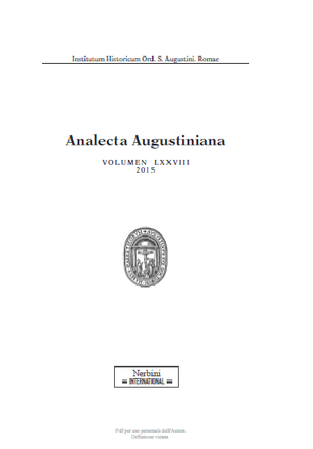
Brian Heffernan, 'Dutch Augustinians and the Second World War', Analecta Augustiniana, 78 (2015), pp. 161-178.
This article examines the experiences of the Dutch Augustinians during the Second World War. By the beginning of the German occupation of the Netherlands in 1940, most Catholics had become integrated into the Dutch nation state. A majority of them proved unsusceptible to the lure of fascism and Nazism, which they regarded as 'new paganism'. Others, primarily educated young Catholics, were dissatisfied with the complacency of their political and clerical leaders and longed for radical alternatives.
As educators and parish ministers, Augustinians came in contact with both views. This article looks first at their attitudes towards right-wing politics, anti-Semitism and parliamentary democracy in the interwar years, before discussing the province’s war-time vicissitudes. It concludes by assessing the longer-term effects of the occupation on the Dutch Augustinian community.
This article examines the experiences of the Dutch Augustinians during the Second World War. By the beginning of the German occupation of the Netherlands in 1940, most Catholics had become integrated into the Dutch nation state. A majority of them proved unsusceptible to the lure of fascism and Nazism, which they regarded as 'new paganism'. Others, primarily educated young Catholics, were dissatisfied with the complacency of their political and clerical leaders and longed for radical alternatives.
As educators and parish ministers, Augustinians came in contact with both views. This article looks first at their attitudes towards right-wing politics, anti-Semitism and parliamentary democracy in the interwar years, before discussing the province’s war-time vicissitudes. It concludes by assessing the longer-term effects of the occupation on the Dutch Augustinian community.
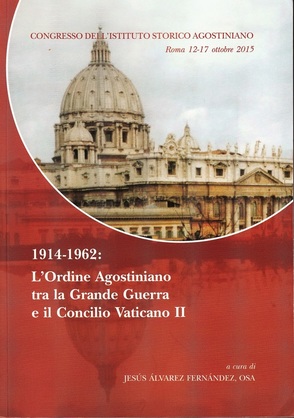
Brian Heffernan, ‘The Dutch Augustinians, 1920-1962. Expansion and the discovery of Augustinian identity’, in Jesús Álvarez Fernández (ed), 1914-1962. L’ordine agostiniano tra la Grande Guerra e il Concilio Vaticano II (Rome: Institutum Historicum Augustinianum, 2015), pp. 799-817.
For the Dutch Augustinian province, the forty years or so between 1920 and the opening of the Second Vatican Council in 1962 were a period of great expansion. Membership swelled from 93 in 1920 to its historical peak of nearly 400 in 1960; more than a fourfold increase. But there was more to this expansion than numerical growth alone. Parish ministry lost its status as the province’s largest field of work, and Dutch Augustinians became active in other domains, such as secondary education, the missions, academic research, chaplaincy work and adult education. Expansion also meant the arrival of a new generation of Augustinians, many of whom were better educated than the older friars. These young intellectuals became important drivers of the new discovery of an Augustinian identity based on Augustine. This article traces the outlines both of the province’s expansion and of this changing sense of identity.
For the Dutch Augustinian province, the forty years or so between 1920 and the opening of the Second Vatican Council in 1962 were a period of great expansion. Membership swelled from 93 in 1920 to its historical peak of nearly 400 in 1960; more than a fourfold increase. But there was more to this expansion than numerical growth alone. Parish ministry lost its status as the province’s largest field of work, and Dutch Augustinians became active in other domains, such as secondary education, the missions, academic research, chaplaincy work and adult education. Expansion also meant the arrival of a new generation of Augustinians, many of whom were better educated than the older friars. These young intellectuals became important drivers of the new discovery of an Augustinian identity based on Augustine. This article traces the outlines both of the province’s expansion and of this changing sense of identity.
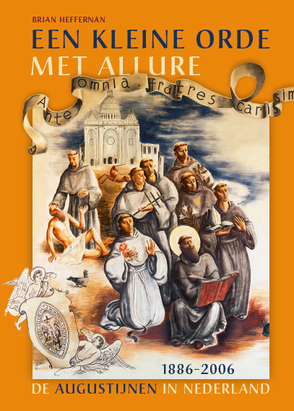
Brian Heffernan, Een kleine orde met allure. De augustijnen in Nederland, 1886-2006 (Hilversum: Verloren, 2015)
('A small order with a presence. The Augustinians in the Netherlands, 1886-2006')
This book tells the story of the Augustinians in the Netherlands. At the end of the nineteenth century this religious community consisted of a handful of parish ministers. During the twentieth century, they remained a relatively small order despite growth. But their involvement in secondary education gave the Augustinians a certain prestige in Dutch Catholic society. Brian Heffernan discusses both their external activities
and their internal community life, while not ignoring the darker side of their
history.
The Augustinians were a small order with a presence. They were parish ministers and campaigners for the Catholic cause, but on the basis of their old tradition they also saw themselves as monks and hermits. In the 1960s they regarded themselves as bearers of renewal, just as many religious; nowadays mostly as promoters of the spirituality of Augustine. These changing and often conflicting narratives provide a framework for the story, in which the constant reinvention of Augustinian identity holds centre stage.
For an interview I recently gave to KNR (Dutch Conference of Religious) about the book take a look at their website.
'Die Ordensgeschichte kann die Grundlage einer katholischen Gesellschaftsgeschichte werden, wenn ihre Vieldimensionalität …ausgeschöpft wird. … Brian Heffernan hat … eine große Gesamtdarstellung der niederländischen Augustiner erarbeitet, die diese integrierende Perspektive exemplarisch umsetzt. ... Klare, aber nicht starre erkenntnisleitende Perspektiven und eine methodisch aufgeschlossene Einordnung in den Forschungsstand haben die Bewältigung dieser empirischen Grundlage und die Identifikation von wesentlichen Entwicklungslinien und Hauptproblemen möglich gemacht. ... Seine Abwägung über Nutzen und Grenzen eines sensiblen Umgangs mit oral history, … ist ein mustergültiges Stück reflektierender Quellenkritik, das man in jedem historischen Proseminar gut gebrauchen kann.' - Rolf-Ulrich Kunze in Church History and Religious Culture, 95 (2015).
'De augustijnen vormden een "kleine orde met allure", zo laat historicus Brian Heffernan zien in de gelijknamige studie, waarin hij een levendig beeld schetst van de augustijnen in Nederland. Hij pakte zijn onderwerp breed aan...' - Klaas van der Zwaag in Reformatorisch Dagblad (8 December 2015).
'Ik heb dit boek geboeid en uitsluitend met onderbrekingen voor de nachtrust gelezen. ... Wie aan een striptease begint moet er rekening mee houden dat hij vroeg of laat rondloopt in de nieuwe kleren van de keizer. De schrijver van dit boek is het jongetje in de menigte dat roept dat de keizer naakt is, waarmee hij ook de ogen van de lezers voor dat onweerlegbare feit opent. ... boeiend boek ...' - Ton van Schaik in Augustijns Forum (December 2015).
'... een uitstekende prestatie ... een mooi resultaat, en ik heb het ook geboeid gelezen. ... Het is de verdienste van de auteur dat het betoog goed te volgen is, geen geheimtaal bevat en goed geïllustreerd is.' - Bert Laeyendecker in Augustijns Forum (December 2015).
'...gedegen studie ... Pijnlijke hoofdstukken uit de geschiedenis, zoals het seksueel misbruik en de onderlinge spanningen, worden niet verzwegen. Een boek met allure over een orde met allure.' - Peter Nissen in NBD Biblion purchasing information (January 2016).
'Brian Heffernan ... heeft een boek over deze orde gepubliceerd, dat om zijn grondige analyse en situering in de kerkgeschiedenis ruime aandacht verdient. ... Naast de activiteiten is de eigen identiteit of spiritualiteit een andere pijler van dit boek. Hierin ligt de grote kracht van Heffernan: onderzoek naar wisselende zelfbeelden, mede gestaafd door interviews. ... Terecht typeert Heffernan de orde als een "met allure". De auteur heeft de orde grondig geanalyseerd en doordacht, prima de continuïteit en de discontinuïteit van de zelfbeelden weergegeven, en met dit alles de kennis over de kerkgeschiedenis van de twintigste eeuw verrijkt. Daarbij hanteert hij een fraaie schrijfstijl. ... Heffernan levert een groepsportret van de leden en laat (te) weinig ruimte voor individuele persoonsbeschrijvingen. ... De auteur, de augustijnen en de lezers mogen zich gelukkig prijzen met dit boek.' - Guus Bary in Tijdschrift voor Nederlandse Kerkgeschiedenis, 19, 1 (March 2016), pp. 36-8.
'De welgekozen titel ... is een vooraankondiging van wat in dit boek gaat komen: een prachtig geschreven en buitengewoon precies geformuleerde geschiedschrijving. ... Wat naar mijn mening ... de grootste prestatie is van de auteur, is de verwerking van de meest recente ontwikkelingen in de historiografie van religieuze instituten en van verzuiling en ontzuiling. Hij verwerkt belangrijke studies ... soepel in deze geschiedenis, die zo leesbaar is, dat het je bijna zou ontgaan hoe grondig hij is onderbouwd.' - Lodewijk Winkeler in Trajecta, 17 May 2016 (www.trajectaportal.eu).
'Hiermee levert [Heffernan] een serieuze aanzet tot een meer synthetische en comparatieve studie van de geschiedenis van ordes en congregaties, sinds lange tijd dé verzuchting van vorsers die bezig zijn met dit onderzoeksveld. ... Ten slotte beschrijft H. op een fijngevoelige en genuanceerde manier de moeilijke periode vanaf de jaren zestig tot aan het begin van de jaren 2000 ... Dit bevattelijk geschreven, duidelijk gestructureerde en mooi vormgegeven boek is een aanrader voor iedereen met een brede interesse in de religieuze geschiedenis van de Lage Landen.' - Anton Milh in Tijdschrift voor Theologie, 56, 2 (2016), p. 198.
'... toekomende generaties [kunnen] zich dankzij congregatie- en ordegeschiedenissen verdiepen in de drijfveren van de broers en zussen van hun (over)grootouders ... Een van die boeken, vervaardigd in opdracht van de Nederlandse augustijnen, is het voorliggende boek ... [Heffernan] vertelt ons over de (numerieke) opkomst en neergang van deze in verhouding ... betrekkelijk kleine groep religieuzen ...' - Charles Caspers in Noordbrabants Historisch Jaarboek, 33 (2016), pp. 225-6.
'Heffernan ... delivers ... a well-documented and readable account of the followers of St. Augustine in the Netherlands in the late modern period. ... gives a serious impetus towards a more synthetic and comparative approach of the history of religious orders and congregations. ... This comprehensible, clearly structured and nicely edited volume is highly recommended to everyone with a broad interest in the history of religious life.' - Anton Milh in Augustiniana, 66 (2016), pp. 290-3.
'De worsteling met de identiteit vormt dan ook een belangrijke leidraad in deze studie ... In het boek van Heffernan wordt de geschiedenis van de augustijnen in Nederland vaak vergeleken met die van de franciscanen en dominicanen. ... een zeer lezenswaardig studie ..., waarin de geschiedenis van deze orde op een gedegen en heldere manier binnen de context van de geschiedenis van de Katholieke Kerk is geplaatst ...' - Vefie Poels in DNK Documentatieblad voor de Nederlandse Kerkgeschiedenis, 42/90 (2019) pp. 99-101.
('A small order with a presence. The Augustinians in the Netherlands, 1886-2006')
This book tells the story of the Augustinians in the Netherlands. At the end of the nineteenth century this religious community consisted of a handful of parish ministers. During the twentieth century, they remained a relatively small order despite growth. But their involvement in secondary education gave the Augustinians a certain prestige in Dutch Catholic society. Brian Heffernan discusses both their external activities
and their internal community life, while not ignoring the darker side of their
history.
The Augustinians were a small order with a presence. They were parish ministers and campaigners for the Catholic cause, but on the basis of their old tradition they also saw themselves as monks and hermits. In the 1960s they regarded themselves as bearers of renewal, just as many religious; nowadays mostly as promoters of the spirituality of Augustine. These changing and often conflicting narratives provide a framework for the story, in which the constant reinvention of Augustinian identity holds centre stage.
For an interview I recently gave to KNR (Dutch Conference of Religious) about the book take a look at their website.
'Die Ordensgeschichte kann die Grundlage einer katholischen Gesellschaftsgeschichte werden, wenn ihre Vieldimensionalität …ausgeschöpft wird. … Brian Heffernan hat … eine große Gesamtdarstellung der niederländischen Augustiner erarbeitet, die diese integrierende Perspektive exemplarisch umsetzt. ... Klare, aber nicht starre erkenntnisleitende Perspektiven und eine methodisch aufgeschlossene Einordnung in den Forschungsstand haben die Bewältigung dieser empirischen Grundlage und die Identifikation von wesentlichen Entwicklungslinien und Hauptproblemen möglich gemacht. ... Seine Abwägung über Nutzen und Grenzen eines sensiblen Umgangs mit oral history, … ist ein mustergültiges Stück reflektierender Quellenkritik, das man in jedem historischen Proseminar gut gebrauchen kann.' - Rolf-Ulrich Kunze in Church History and Religious Culture, 95 (2015).
'De augustijnen vormden een "kleine orde met allure", zo laat historicus Brian Heffernan zien in de gelijknamige studie, waarin hij een levendig beeld schetst van de augustijnen in Nederland. Hij pakte zijn onderwerp breed aan...' - Klaas van der Zwaag in Reformatorisch Dagblad (8 December 2015).
'Ik heb dit boek geboeid en uitsluitend met onderbrekingen voor de nachtrust gelezen. ... Wie aan een striptease begint moet er rekening mee houden dat hij vroeg of laat rondloopt in de nieuwe kleren van de keizer. De schrijver van dit boek is het jongetje in de menigte dat roept dat de keizer naakt is, waarmee hij ook de ogen van de lezers voor dat onweerlegbare feit opent. ... boeiend boek ...' - Ton van Schaik in Augustijns Forum (December 2015).
'... een uitstekende prestatie ... een mooi resultaat, en ik heb het ook geboeid gelezen. ... Het is de verdienste van de auteur dat het betoog goed te volgen is, geen geheimtaal bevat en goed geïllustreerd is.' - Bert Laeyendecker in Augustijns Forum (December 2015).
'...gedegen studie ... Pijnlijke hoofdstukken uit de geschiedenis, zoals het seksueel misbruik en de onderlinge spanningen, worden niet verzwegen. Een boek met allure over een orde met allure.' - Peter Nissen in NBD Biblion purchasing information (January 2016).
'Brian Heffernan ... heeft een boek over deze orde gepubliceerd, dat om zijn grondige analyse en situering in de kerkgeschiedenis ruime aandacht verdient. ... Naast de activiteiten is de eigen identiteit of spiritualiteit een andere pijler van dit boek. Hierin ligt de grote kracht van Heffernan: onderzoek naar wisselende zelfbeelden, mede gestaafd door interviews. ... Terecht typeert Heffernan de orde als een "met allure". De auteur heeft de orde grondig geanalyseerd en doordacht, prima de continuïteit en de discontinuïteit van de zelfbeelden weergegeven, en met dit alles de kennis over de kerkgeschiedenis van de twintigste eeuw verrijkt. Daarbij hanteert hij een fraaie schrijfstijl. ... Heffernan levert een groepsportret van de leden en laat (te) weinig ruimte voor individuele persoonsbeschrijvingen. ... De auteur, de augustijnen en de lezers mogen zich gelukkig prijzen met dit boek.' - Guus Bary in Tijdschrift voor Nederlandse Kerkgeschiedenis, 19, 1 (March 2016), pp. 36-8.
'De welgekozen titel ... is een vooraankondiging van wat in dit boek gaat komen: een prachtig geschreven en buitengewoon precies geformuleerde geschiedschrijving. ... Wat naar mijn mening ... de grootste prestatie is van de auteur, is de verwerking van de meest recente ontwikkelingen in de historiografie van religieuze instituten en van verzuiling en ontzuiling. Hij verwerkt belangrijke studies ... soepel in deze geschiedenis, die zo leesbaar is, dat het je bijna zou ontgaan hoe grondig hij is onderbouwd.' - Lodewijk Winkeler in Trajecta, 17 May 2016 (www.trajectaportal.eu).
'Hiermee levert [Heffernan] een serieuze aanzet tot een meer synthetische en comparatieve studie van de geschiedenis van ordes en congregaties, sinds lange tijd dé verzuchting van vorsers die bezig zijn met dit onderzoeksveld. ... Ten slotte beschrijft H. op een fijngevoelige en genuanceerde manier de moeilijke periode vanaf de jaren zestig tot aan het begin van de jaren 2000 ... Dit bevattelijk geschreven, duidelijk gestructureerde en mooi vormgegeven boek is een aanrader voor iedereen met een brede interesse in de religieuze geschiedenis van de Lage Landen.' - Anton Milh in Tijdschrift voor Theologie, 56, 2 (2016), p. 198.
'... toekomende generaties [kunnen] zich dankzij congregatie- en ordegeschiedenissen verdiepen in de drijfveren van de broers en zussen van hun (over)grootouders ... Een van die boeken, vervaardigd in opdracht van de Nederlandse augustijnen, is het voorliggende boek ... [Heffernan] vertelt ons over de (numerieke) opkomst en neergang van deze in verhouding ... betrekkelijk kleine groep religieuzen ...' - Charles Caspers in Noordbrabants Historisch Jaarboek, 33 (2016), pp. 225-6.
'Heffernan ... delivers ... a well-documented and readable account of the followers of St. Augustine in the Netherlands in the late modern period. ... gives a serious impetus towards a more synthetic and comparative approach of the history of religious orders and congregations. ... This comprehensible, clearly structured and nicely edited volume is highly recommended to everyone with a broad interest in the history of religious life.' - Anton Milh in Augustiniana, 66 (2016), pp. 290-3.
'De worsteling met de identiteit vormt dan ook een belangrijke leidraad in deze studie ... In het boek van Heffernan wordt de geschiedenis van de augustijnen in Nederland vaak vergeleken met die van de franciscanen en dominicanen. ... een zeer lezenswaardig studie ..., waarin de geschiedenis van deze orde op een gedegen en heldere manier binnen de context van de geschiedenis van de Katholieke Kerk is geplaatst ...' - Vefie Poels in DNK Documentatieblad voor de Nederlandse Kerkgeschiedenis, 42/90 (2019) pp. 99-101.
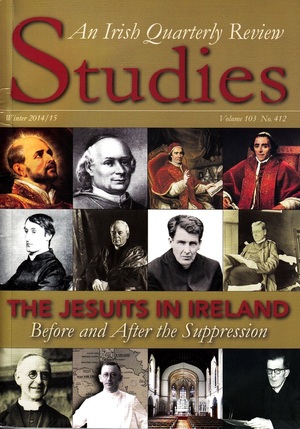
Brian Heffernan, 'Discerning the spirits. The Irish Jesuits and political violence, 1919-21', Studies. An Irish Quarterly Review, 103, 412 (2014/2015) (The Jesuits in Ireland. Before and after the suppression), pp. 552-61.
The rise of republicanism as the main force in Irish politics after the 1916 Easter rising presented Irish Catholic priests with a dilemma. They had long maintained good
links with the nationalist leadership, and the successes of the new republicanism called this old allegiance into question. The problem became most acute during the guerrilla war that began in 1919 with the aim of obtaining freedom for the Irish republic.
The Irish Jesuits felt this dilemma particularly strongly. Their colleges had produced generations of middle-class Catholics who had looked primarily to the existing political establishment and to home rule for advancement. Many of them had lost their lives fighting for the British army in the trenches. At the same time, however, Jesuit alumni were beginning to appear among the names of celebrated republican freedom fighters. This article addresses the Irish Jesuits’ response to political violence between 1919 and 1921 against the background of the wider clerical reaction. It shows that the atrocities of guerrilla warfare effected a change of attitude that made an initially hesitant majority willing to come to terms with the new order.
The rise of republicanism as the main force in Irish politics after the 1916 Easter rising presented Irish Catholic priests with a dilemma. They had long maintained good
links with the nationalist leadership, and the successes of the new republicanism called this old allegiance into question. The problem became most acute during the guerrilla war that began in 1919 with the aim of obtaining freedom for the Irish republic.
The Irish Jesuits felt this dilemma particularly strongly. Their colleges had produced generations of middle-class Catholics who had looked primarily to the existing political establishment and to home rule for advancement. Many of them had lost their lives fighting for the British army in the trenches. At the same time, however, Jesuit alumni were beginning to appear among the names of celebrated republican freedom fighters. This article addresses the Irish Jesuits’ response to political violence between 1919 and 1921 against the background of the wider clerical reaction. It shows that the atrocities of guerrilla warfare effected a change of attitude that made an initially hesitant majority willing to come to terms with the new order.
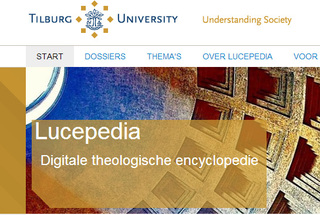
Wim Sleddens, O.S.A., and Brian Heffernan, ‘De Orde der Augustijnen’ (December 2014), articles on Lucepedia. Digitale theologische encyclopedie, Tilburg University.
A collection of articles and resources dedicated to the Augustinian order and its history:
I. ‘Van Augustinus naar Orde der Augustijnen (O.S.A.). Een lange weg’ (From Augustine to the Order of Augustinians [O.S.A.]. A long road) by Wim Sleddens, O.S.A.
II. ‘Geschiedenis van de orde’ (History of the order) by Brian Heffernan.
III. ‘Augustijnen in Nederland’ (Augustinians in the Netherlands) by Brian Heffernan.
A collection of articles and resources dedicated to the Augustinian order and its history:
I. ‘Van Augustinus naar Orde der Augustijnen (O.S.A.). Een lange weg’ (From Augustine to the Order of Augustinians [O.S.A.]. A long road) by Wim Sleddens, O.S.A.
II. ‘Geschiedenis van de orde’ (History of the order) by Brian Heffernan.
III. ‘Augustijnen in Nederland’ (Augustinians in the Netherlands) by Brian Heffernan.
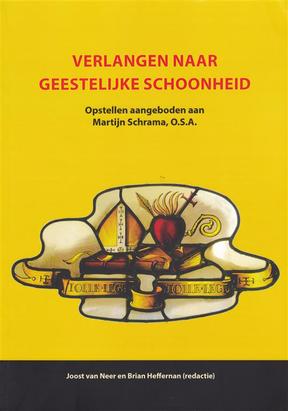
Brian Heffernan, 'Van Groote Vader tot inspiratiebron. De Nederlandse augustijnen en Augustinus sinds de negentiende eeuw’, in Joost van Neer and Brian Heffernan (eds), Verlangen naar geestelijke schoonheid. Opstellen aangeboden aan Martijn Schrama, O.S.A. (Bergambacht: Uitgeverij 2VM, 2014), pp. 157-68.
Religious orders often present themselves as bearers and disseminators of a particular school of spirituality; the Augustinians for instance as followers of the spirituality of Augustine (354-430): Augustine as the source of inspiration and the spiritual master of the Augustinians. The current article demonstrates that this notion is a relatively recent one – for the Dutch Augustinians it dates to the 1980s and 1990s. It emerged as a response to the changing function of religious in society and to their disappointing future prospects, but also to the way religion is currently lived and experienced in society. The article shows that the significance that Augustine has had for the Dutch Augustinians has changed on a number of occasions since the nineteenth century. It concludes that these changes were the result of new constructions of Augustinian identity: the Augustinian reception of Augustine was often a function of the community’s preferred narrative about its own identity.
Religious orders often present themselves as bearers and disseminators of a particular school of spirituality; the Augustinians for instance as followers of the spirituality of Augustine (354-430): Augustine as the source of inspiration and the spiritual master of the Augustinians. The current article demonstrates that this notion is a relatively recent one – for the Dutch Augustinians it dates to the 1980s and 1990s. It emerged as a response to the changing function of religious in society and to their disappointing future prospects, but also to the way religion is currently lived and experienced in society. The article shows that the significance that Augustine has had for the Dutch Augustinians has changed on a number of occasions since the nineteenth century. It concludes that these changes were the result of new constructions of Augustinian identity: the Augustinian reception of Augustine was often a function of the community’s preferred narrative about its own identity.
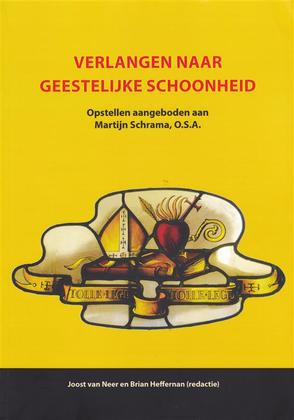
Joost van Neer and Brian Heffernan (eds), Verlangen naar geestelijke schoonheid. Opstellen aangeboden aan Martijn Schrama, O.S.A. (Bergambacht: Uitgeverij 2VM, 2014).
Augustine of Hippo (354-430) is the main subject of this collection of essays. Centuries after his lifetime, this church father still attracts much attention. Not only because he is one of the greatest thinkers of Western history, but also because his writings on the Christian faith continue to inspire. This Dutch-language volume contains articles discussing aspects of Augustine's work by scholars from the Netherlands and abroad. It also addresses the influence Augustine has had on history, from theology and philosophy to art and the religious life.
In doing so, this collection closely reflects the most important themes in the work of Martijn Schrama, O.S.A. (1944). Schrama has been a major contributor to scholarly research on medieval theology and the history of the Augustinian Order, while much of his work exudes a great love for Augustine. Like Augustine, Schrama is a lover of spiritual beauty (Rule, 8). He has inspired many to cherish the same desire.
In order to honour his life and work, thirteen of Schrama's friends have offered him this 'Festschrift' on the occasion of his seventieth birthday. Editors are Joost van Neer and Brian Heffernan.
'De redacteuren van de vriendenbundel Joost van Neer en Brian Heffernan typeren
Schrama als een gentleman. Daarmee is niets te veel gezegd. Vriendelijkheid, gevoel voor stijl en mildheid typeren zijn persoon.' - Klaas van der Zwaag in Reformatorisch Dagblad (5 januari 2015).
'De schrijvers van de artikelen hebben allen hun sporen verdiend in de theologie en zijn zeer deskundig in de onderwerpen die zij behandelen. ... Wie geïnteresseerd is in het gedachtegoed van Augustinus kan zijn of haar hart ophalen. De reformatorische
traditie is schatplichtig aan deze kerkvader.' - P.A. Zevenbergen in GezinsGids (7 januari 2016).
Augustine of Hippo (354-430) is the main subject of this collection of essays. Centuries after his lifetime, this church father still attracts much attention. Not only because he is one of the greatest thinkers of Western history, but also because his writings on the Christian faith continue to inspire. This Dutch-language volume contains articles discussing aspects of Augustine's work by scholars from the Netherlands and abroad. It also addresses the influence Augustine has had on history, from theology and philosophy to art and the religious life.
In doing so, this collection closely reflects the most important themes in the work of Martijn Schrama, O.S.A. (1944). Schrama has been a major contributor to scholarly research on medieval theology and the history of the Augustinian Order, while much of his work exudes a great love for Augustine. Like Augustine, Schrama is a lover of spiritual beauty (Rule, 8). He has inspired many to cherish the same desire.
In order to honour his life and work, thirteen of Schrama's friends have offered him this 'Festschrift' on the occasion of his seventieth birthday. Editors are Joost van Neer and Brian Heffernan.
'De redacteuren van de vriendenbundel Joost van Neer en Brian Heffernan typeren
Schrama als een gentleman. Daarmee is niets te veel gezegd. Vriendelijkheid, gevoel voor stijl en mildheid typeren zijn persoon.' - Klaas van der Zwaag in Reformatorisch Dagblad (5 januari 2015).
'De schrijvers van de artikelen hebben allen hun sporen verdiend in de theologie en zijn zeer deskundig in de onderwerpen die zij behandelen. ... Wie geïnteresseerd is in het gedachtegoed van Augustinus kan zijn of haar hart ophalen. De reformatorische
traditie is schatplichtig aan deze kerkvader.' - P.A. Zevenbergen in GezinsGids (7 januari 2016).
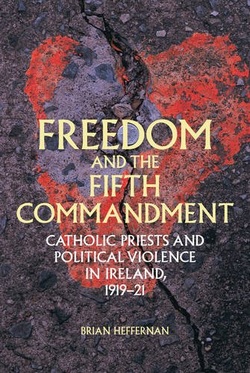
Brian Heffernan, Freedom and the Fifth Commandment. Catholic priests and political violence in Ireland, 1919-21 (Manchester and New York: Manchester University Press, 2014).
The guerrilla war waged between the IRA and the crown forces between 1919 and 1921 was a pivotal episode in the modern history of Ireland. This book addresses the War of Independence from a new perspective by focusing on the attitude of a powerful social elite: the Catholic clergy. The close relationship between Irish nationalism and Catholicism was put to the test when a pugnacious new republicanism emerged after the 1916 Easter rising. When the IRA and the crown forces became involved in a guerrilla war between 1919 and 1921, priests had to define their position anew.
Using a wealth of source material, much of it newly available, this book assesses the clergy’s response to political violence. It describes how the image of shared victimhood at the hands of the British helped to contain tensions between the clergy and the republican
movement, and shows how the links between Catholicism and Irish nationalism were
sustained.
'A page-turner ... beautifully shaped ... [a] fine study which will be a standard work on this subject for many years to come' - J. Anthony Gaughan in The Irish Catholic (19 June 2014)
'Meticulously using both archival and newspaper sources ... [a] worthwhile study' - James Flint in The Journal of Ecclesiastical History, 66, 2 (April 2015).
'Stands out ... expertly chronicles the relationship between Catholic priests and violence in Ireland from 1919 to 1921. Heffernan has vividly filled a large gap in historical knowledge about how priests navigated exceptionally difficult circumstances and volatile times' - Diarmaid Ferriter in The Irish Times (5 December 2015).
'... hugely impressive, illuminating and excellently researched book. Drawing on diocesan archives, newspapers, witness statements and contemporary correspondence, Heffernan skilfully weaves these sources together into a judicious, well-written overview' - Diarmaid Ferriter in The Irish Times (9 January 2016).
The guerrilla war waged between the IRA and the crown forces between 1919 and 1921 was a pivotal episode in the modern history of Ireland. This book addresses the War of Independence from a new perspective by focusing on the attitude of a powerful social elite: the Catholic clergy. The close relationship between Irish nationalism and Catholicism was put to the test when a pugnacious new republicanism emerged after the 1916 Easter rising. When the IRA and the crown forces became involved in a guerrilla war between 1919 and 1921, priests had to define their position anew.
Using a wealth of source material, much of it newly available, this book assesses the clergy’s response to political violence. It describes how the image of shared victimhood at the hands of the British helped to contain tensions between the clergy and the republican
movement, and shows how the links between Catholicism and Irish nationalism were
sustained.
'A page-turner ... beautifully shaped ... [a] fine study which will be a standard work on this subject for many years to come' - J. Anthony Gaughan in The Irish Catholic (19 June 2014)
'Meticulously using both archival and newspaper sources ... [a] worthwhile study' - James Flint in The Journal of Ecclesiastical History, 66, 2 (April 2015).
'Stands out ... expertly chronicles the relationship between Catholic priests and violence in Ireland from 1919 to 1921. Heffernan has vividly filled a large gap in historical knowledge about how priests navigated exceptionally difficult circumstances and volatile times' - Diarmaid Ferriter in The Irish Times (5 December 2015).
'... hugely impressive, illuminating and excellently researched book. Drawing on diocesan archives, newspapers, witness statements and contemporary correspondence, Heffernan skilfully weaves these sources together into a judicious, well-written overview' - Diarmaid Ferriter in The Irish Times (9 January 2016).
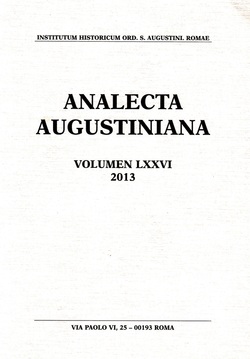
Brian Heffernan, 'Dutch Augustinian theologians and the Second Vatican Council', Analecta Augustiniana, 76 (2013), pp. 415-45.
Many of the reformist theologians whose views were adopted by the majority at the Second
Vatican Council (1962-1965) were members of religious orders. The 'old' orders had invested much in intellectual endeavour since their revival in the nineteenth century, and this had produced a generation of exceptional theologians. While the Augustinians played only a minor role at the council, they could by the 1960s nonetheless boast of a number of talented intellectuals, among them several members of the Dutch province.
This article examines the work and thought of these Dutch Augustinian theologians, focusing in particular on the conciliar activities of Ansfried Hulsbosch and Athanasius van der Weijden. It investigates their dealings with the council in order to gauge the scope of their expectations for the church and for theology.
Many of the reformist theologians whose views were adopted by the majority at the Second
Vatican Council (1962-1965) were members of religious orders. The 'old' orders had invested much in intellectual endeavour since their revival in the nineteenth century, and this had produced a generation of exceptional theologians. While the Augustinians played only a minor role at the council, they could by the 1960s nonetheless boast of a number of talented intellectuals, among them several members of the Dutch province.
This article examines the work and thought of these Dutch Augustinian theologians, focusing in particular on the conciliar activities of Ansfried Hulsbosch and Athanasius van der Weijden. It investigates their dealings with the council in order to gauge the scope of their expectations for the church and for theology.
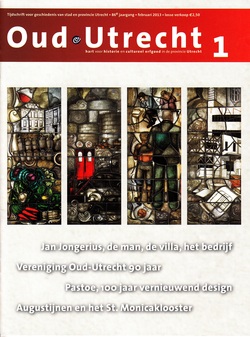
Brian Heffernan, ‘Het St. Monicaklooster aan de Herenweg. Begin van augustijnse herleving’, Oud-Utrecht. Tijdschrift voor geschiedenis van stad en provincie Utrecht, 86, 1 (February 2013), pp. 16-20.
The most enduring image of St. Monica’s church, Herenweg, Utrecht, is probably a photograph taken while the church was being demolished. The spire of this Augustinian parish church was pulled down on 11 October 1977,
and a photograph taken in mid-collapse is symbolic of the decline of Dutch Catholicism.
Not a hundred years before, in 1886, the inauguration of St. Monica’s church symbolised the exact opposite. For the Augustinians, one of the Netherlands’ oldest religious orders, the building of this church and its presbytery-priory was an important turning point in their history. In highlighting the importance of St. Monica’s, this article describes the earliest phase of Augustinian revival in the Netherlands.
The most enduring image of St. Monica’s church, Herenweg, Utrecht, is probably a photograph taken while the church was being demolished. The spire of this Augustinian parish church was pulled down on 11 October 1977,
and a photograph taken in mid-collapse is symbolic of the decline of Dutch Catholicism.
Not a hundred years before, in 1886, the inauguration of St. Monica’s church symbolised the exact opposite. For the Augustinians, one of the Netherlands’ oldest religious orders, the building of this church and its presbytery-priory was an important turning point in their history. In highlighting the importance of St. Monica’s, this article describes the earliest phase of Augustinian revival in the Netherlands.
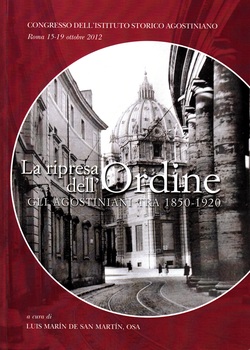
Brian Heffernan, ‘"Spiritus Ordinis nostri paulatim reviviscere incepit". Augustinian revival in the Netherlands, 1886-1920’, in Luis Marín de San Martín (ed.), La ripresa dell’ordine. Gli agostiniani tra 1850-1920. Congresso dell’Istituto Storico Agostiniano, Roma 15-19 ottobre 2012 (Rome: Institutum Historicum Augustinianum, 2012), pp. 349-73.
In mid-nineteenth century the Augustinian mission in the Netherlands consisted of a handful of priests who worked in three parishes in the west of the country. There were no priories, and aspiring entrants had to be sent abroad for their noviciate and studies. By the 1880s, a small number of enterprising Augustinians was plotting a plan for the numerical expansion and the internal transformation of the mission.
Three decades later, the mission was an independent province, three priories had been built, membership figures were increasing, entrants were fully educated at home and the province was focusing on new fields of work besides parish ministry. This article attempts to answer the question how this process of revival came about. In doing so, it pays close attention to the development of a new Dutch Augustinian self-image and to the methods used to put this image into effect.
In mid-nineteenth century the Augustinian mission in the Netherlands consisted of a handful of priests who worked in three parishes in the west of the country. There were no priories, and aspiring entrants had to be sent abroad for their noviciate and studies. By the 1880s, a small number of enterprising Augustinians was plotting a plan for the numerical expansion and the internal transformation of the mission.
Three decades later, the mission was an independent province, three priories had been built, membership figures were increasing, entrants were fully educated at home and the province was focusing on new fields of work besides parish ministry. This article attempts to answer the question how this process of revival came about. In doing so, it pays close attention to the development of a new Dutch Augustinian self-image and to the methods used to put this image into effect.
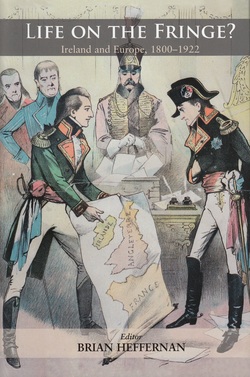
Brian Heffernan, Marta Ramón, Pierre Ranger and Zsuzsanna Zarka (eds), Life on the fringe? Ireland and Europe, 1800-1922 (Dublin and Portland, OR: Irish Academic Press, 2012).
Scholars of modern Ireland have often been too immersed in the intricacies of Anglo-Irish relations to cast a wider glance toward the European continent. Was Ireland really on the fringe of Europe during the 19th century, trapped into an Anglo-Irish Neverland by the Act of Union, oblivious to the progress of European events?
This volume challenges such notions and explores the general theme of ‘Ireland and Europe’ from different and fascinating perspectives. This thematic survey places a number of major themes of Irish history in their European context from 1800 to 1922.
The Irish-European connections during the 19th century span the entire continent from France to Russia, and from Finland to Spain. This book takes Irish history as an organic component of European developments, breaking the Western Europe bias of much of the existing scholarship.
'A good collection of pieces, covering a wide variety of nations, subjects and ideas. ... Heffernan succeeds in turning what could have been untidy and unwieldy into an organised collection that covers many topics and comparative studies while maintaining strong thematic elements' - M.P. McCabe in English Historical Review (August 2014).
Scholars of modern Ireland have often been too immersed in the intricacies of Anglo-Irish relations to cast a wider glance toward the European continent. Was Ireland really on the fringe of Europe during the 19th century, trapped into an Anglo-Irish Neverland by the Act of Union, oblivious to the progress of European events?
This volume challenges such notions and explores the general theme of ‘Ireland and Europe’ from different and fascinating perspectives. This thematic survey places a number of major themes of Irish history in their European context from 1800 to 1922.
The Irish-European connections during the 19th century span the entire continent from France to Russia, and from Finland to Spain. This book takes Irish history as an organic component of European developments, breaking the Western Europe bias of much of the existing scholarship.
'A good collection of pieces, covering a wide variety of nations, subjects and ideas. ... Heffernan succeeds in turning what could have been untidy and unwieldy into an organised collection that covers many topics and comparative studies while maintaining strong thematic elements' - M.P. McCabe in English Historical Review (August 2014).
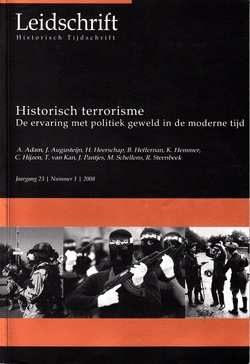
Brian Heffernan, ‘"It is for a nation of martyrs to cultivate constant self-restraint". The Irish Catholic bishops’ attitude to the IRA campaign, 1919-21’, Leidschrift. Historisch tijdschrift, 23, 1 (2008), pp. 151-69.
The guerrilla war fought out between the Irish Republican Army and the British forces in Ireland between 1919 and 1921 presented the Catholic bishops with a particular dilemma. Irish nationalism and Catholicism had long been closely intertwined, and the republican revolutionaries were Catholics almost to a man. Revolutionary violence, however, went against the grain not only of Catholic teaching, but also of the bishops’ traditional political stance.
This article offers a framework for understanding the hierarchy’s response to the political violence engaged in by its own community. The bishops recognised Ireland’s right to self-determination, but rejected the republican argument that an Irish republic had been established in 1916. Nor did they fail to point out the immorality of republican violence. Their main emphasis, however, was on the claim that the British government was ultimately responsible for the struggle.
The guerrilla war fought out between the Irish Republican Army and the British forces in Ireland between 1919 and 1921 presented the Catholic bishops with a particular dilemma. Irish nationalism and Catholicism had long been closely intertwined, and the republican revolutionaries were Catholics almost to a man. Revolutionary violence, however, went against the grain not only of Catholic teaching, but also of the bishops’ traditional political stance.
This article offers a framework for understanding the hierarchy’s response to the political violence engaged in by its own community. The bishops recognised Ireland’s right to self-determination, but rejected the republican argument that an Irish republic had been established in 1916. Nor did they fail to point out the immorality of republican violence. Their main emphasis, however, was on the claim that the British government was ultimately responsible for the struggle.
Window in Irish chapel, San Gioacchino in Prati, Rome
